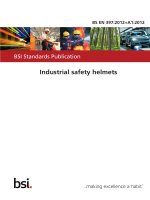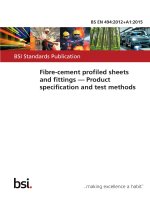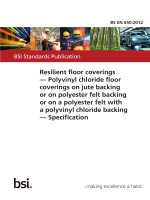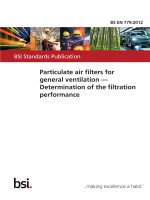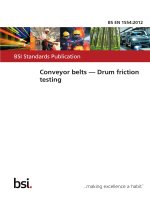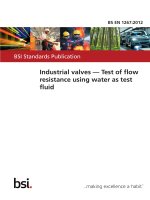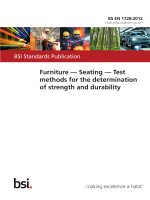Bsi bs en 62027 2012
Bạn đang xem bản rút gọn của tài liệu. Xem và tải ngay bản đầy đủ của tài liệu tại đây (1.29 MB, 38 trang )
BS EN 62027:2012
BSI Standards Publication
Preparation of object lists,
including parts lists
NO COPYING WITHOUT BSI PERMISSION EXCEPT AS PERMITTED BY COPYRIGHT LAW
raising standards worldwide™
BRITISH STANDARD
BS EN 62027:2012
National foreword
This British Standard is the UK implementation of EN 62027:2012.
It is identical to IEC 62027:2011. It supersedes BS EN 62027:2001,
which is withdrawn.
The UK participation in its preparation was entrusted to Technical Committee
GEL/3, Documentation and graphical symbols.
A list of organizations represented on this committee can be obtained on
request to its secretary.
This publication does not purport to include all the necessary provisions of a
contract. Users are responsible for its correct application.
© The British Standards Institution 2012
ISBN 978 0 580 62097 3
ICS 29.020; 01.110
Compliance with a British Standard cannot confer immunity
from legal obligations.
This British Standard was published under the authority of the
Standards Policy and Strategy Committee on 29 February 2012.
Amendments issued since publication
Amd. No.
Date
Text affected
BS EN 62027:2012
EUROPEAN STANDARD
EN 62027
NORME EUROPÉENNE
January 2012
EUROPÄISCHE NORM
ICS 29.020
Supersedes EN 62027:2000
English version
Preparation of object lists, including parts lists
(IEC 62027:2011)
Etablissement des listes d'objet, y compris
des nomenclatures de composants
(CEI 62027:2011)
Erstellung von Objektlisten, einschließlich
Teilelisten
(IEC 62027:2011)
This European Standard was approved by CENELEC on 2011-11-16. CENELEC members are bound to comply
with the CEN/CENELEC Internal Regulations which stipulate the conditions for giving this European Standard
the status of a national standard without any alteration.
Up-to-date lists and bibliographical references concerning such national standards may be obtained on
application to the CEN-CENELEC Management Centre or to any CENELEC member.
This European Standard exists in three official versions (English, French, German). A version in any other
language made by translation under the responsibility of a CENELEC member into its own language and notified
to the CEN-CENELEC Management Centre has the same status as the official versions.
CENELEC members are the national electrotechnical committees of Austria, Belgium, Bulgaria, Croatia, Cyprus,
the Czech Republic, Denmark, Estonia, Finland, France, Germany, Greece, Hungary, Iceland, Ireland, Italy,
Latvia, Lithuania, Luxembourg, Malta, the Netherlands, Norway, Poland, Portugal, Romania, Slovakia, Slovenia,
Spain, Sweden, Switzerland, Turkey and the United Kingdom.
CENELEC
European Committee for Electrotechnical Standardization
Comité Européen de Normalisation Electrotechnique
Europäisches Komitee für Elektrotechnische Normung
Management Centre: Avenue Marnix 17, B - 1000 Brussels
© 2012 CENELEC -
All rights of exploitation in any form and by any means reserved worldwide for CENELEC members.
Ref. No. EN 62027:2012 E
BS EN 62027:2012
EN 62027:2012
Foreword
The text of document 3/1049/FDIS, future edition 2 of IEC 62027, prepared by IEC TC 3 "Information
structures, documentation and graphical symbols" was submitted to the IEC-CENELEC parallel vote and
approved by CENELEC as EN 62027:2012.
The following dates are fixed:
•
•
latest date by which the document has
to be implemented at national level by
publication of an identical national
standard or by endorsement
latest date by which the national
standards conflicting with the
document have to be withdrawn
(dop)
2012-08-16
(dow)
2014-11-16
This document supersedes EN 62027:2000.
EN 62027:2011 includes the following significant technical changes with respect to EN 62027:2000:
— the terminology used in the publication has been adapted to the one used in EN 81346-1:2009,
EN 62507-1:2011 and IEC/PAS 62569-1:2009;
— the term “object list” has been introduced as the generic term, and “parts list” used as a specific term
for object lists associated with the product structure;
— Annex A of the previous edition has been taken away and partly replaced by 6.2 and a reference to
IEC 61355 DB;
— a new Annex A providing guidance on the presentation of subsets of characteristic properties has
been introduced;
— a new Annex B providing source definitions and references to used data element types has been
introduced;
— the examples in the annexes C, D and E (corresponding to B, C and D in the previous edition) have
been provided with comments;
Attention is drawn to the possibility that some of the elements of this document may be the subject of
patent rights. CENELEC [and/or CEN] shall not be held responsible for identifying any or all such patent
rights.
Endorsement notice
The text of the International Standard IEC 62027:2011 was approved by CENELEC as a European
Standard without any modification.
In the official version, for Bibliography, the following notes have to be added for the standards indicated:
IEC 61360-1:2009
NOTE Harmonized as EN 61360-1:2010 (not modified).
IEC 82045-1:2001
NOTE Harmonized as EN 82045-1:2001 (not modified).
IEC 82045-2:2004
NOTE Harmonized as EN 82045-2:2005 (not modified).
ISO 80000 series
NOTE Harmonized in EN ISO 80000 series.
ISO 10303-44:1994
NOTE Harmonized as ENV ISO 10303-44:1995 (not modified).
BS EN 62027:2012
EN 62027:2012
Annex ZA
(normative)
Normative references to international publications
with their corresponding European publications
The following referenced documents are indispensable for the application of this document. For dated
references, only the edition cited applies. For undated references, the latest edition of the referenced
document (including any amendments) applies.
NOTE When an international publication has been modified by common modifications, indicated by (mod), the relevant EN/HD
applies.
Publication
Year
Title
EN/HD
Year
IEC 61082-1
2006
Preparation of documents used in
electrotechnology Part 1: Rules
EN 61082-1
2006
IEC 61355
2008
IEC Collection of standardized and
established document kinds
-
-
IEC 61355-1
2008
Classification and designation of documents
for plants, systems and equipment Part 1: Rules and classification tables
EN 61355-1
2008
IEC 61360
-
Component data dictionary (CDD)
-
-
Structuring of technical information and
documentation
EN 62023
201X
1)
IEC 62023
201X
IEC 62507-1
2010
Identification systems enabling unambiguous EN 62507-1
information interchange - Requirements Part 1: Principles and methods
2011
IEC 81346-1
2009
Industrial systems, installations and
equipment and industrial products Structuring principles and reference
designations Part 1: Basic rules
EN 81346-1
2009
IEC 81346-2
-
EN 81346-2
Industrial systems, installations and
equipment and industrial products Structuring principles and reference
designations Part 2: Classification of objects and codes for
classes
IEC 82045-2
2004
Document management Part 2: Metadata elements and information
reference model
EN 82045-2
2005
IEC/PAS 62569-1
2009
Generic specification of information on
products Part 1: Principles and methods
-
-
ISO 639-1
-
Codes for the representation of names of
languages Part 1: Alpha-2 code
-
-
ISO 6433
-
Technical drawings - Item references
EN ISO 6433
-
ISO 7200
-
Technical product documentation - Data fields EN ISO 7200
in title blocks and document headers
-
1)
At draft stage.
-
1)
BS EN 62027:2012
EN 62027:2012
Publication
Year
Title
EN/HD
Year
ISO 13584-42
2010
Industrial automation systems
and integration Parts library Part 42: Description methodology:
Methodology for structuring parts families
-
-
BS EN 62027:2012
62027 IEC:2011
CONTENTS
INTRODUCTION . .................................................................................................................................. 6
1
Scope . ............................................................................................................................................. 7
2
Normative references . .................................................................................................................. 7
3
Terms and definitions . .................................................................................................................. 8
4
3.1 General terms . .................................................................................................................... 8
3.2 Terms related to documentation . .................................................................................... 10
3.3 Specific terms related to object lists . ............................................................................. 11
3.4 Alphabetical index of terms ............................................................................................. 12
General ......................................................................................................................................... 12
5
4.1 Types of object lists . ........................................................................................................ 12
4.2 Forms of presentation of an object list body ................................................................. 13
4.3 Table header . .................................................................................................................... 13
4.4 List items. ........................................................................................................................... 14
Requirements for the parts list body . ....................................................................................... 14
5.1
5.2
5.3
5.4
6
Classification of parts lists . .............................................................................................. 14
Relation to the specified object . ...................................................................................... 14
Content of a list item . ....................................................................................................... 15
Specification of characteristic properties . ..................................................................... 16
5.4.1 Overview ............................................................................................................... 16
5.4.2 Identification of the occurrence .......................................................................... 16
5.4.3 Usage . ................................................................................................................... 16
5.4.4 Characteristic properties related to the occurrence . ....................................... 17
5.4.5 References related to the occurrence . ............................................................. 17
5.4.6 Amount . ................................................................................................................. 17
5.4.7 Identification of the type of part . ....................................................................... 17
5.4.8 Description of the type of part . ........................................................................... 18
5.4.9 Characteristic properties for the type of part . .................................................. 19
5.4.10 References to documents related to the type of part . .................................... 19
5.5 Layout of the parts list body ............................................................................................ 20
5.5.1 General . ................................................................................................................ 20
5.5.2 Columns in Class A parts lists ........................................................................... 20
5.5.3 Columns in Class B parts lists ........................................................................... 21
5.5.4 List items ............................................................................................................... 21
5.5.5 Sorting of list items . ............................................................................................. 21
Requirements for an object list document . .............................................................................. 22
6.1 General . ............................................................................................................................. 22
6.2 Document kind names ...................................................................................................... 22
Annex A (informative) Presentation of characteristic properties in a list item . ......................... 23
Annex B (normative) Data element type definitions . .................................................................... 25
Annex C (informative) Example of a parts list (object list) document with an parts list
body of Class A . ................................................................................................................................. 28
Annex D (informative) Example of a parts list (object list) document with a parts list
body of Class B . ................................................................................................................................. 29
BS EN 62027:2012
62027 IEC:2011
Annex E (informative) Example of a parts list document for manufacturing purposes
with a parts list body of Class A . ...................................................................................................... 30
Bibliography ......................................................................................................................................... 32
Figure 1 – Illustration of the organization of object lists (in one aspect) . .................................... 6
Figure 2 – Presentation of an object list body in a document . ..................................................... 13
Table 1 – Information contained in a list item for a constituent object ........................................ 15
BS EN 62027:2012
62027 IEC:2011
–6–
INTRODUCTION
An object list is primarily used to list and specify the constituent objects (components) of the
overall object or system to which the object list applies.
It is generally recognized that information on products, installations and systems can be
organized on the basis of tree-like, hierarchical, structures. The structure represents the way
in which an industrial system or a product is divided into sub-systems or components,
designated by the general term “constituent objects”. In the context of this International
Standard, ”object” refers to any entity treated in a process of development, implementation,
usage and disposal of a plant, installation, system, equipment, etc., or part thereof, in
accordance with the definition in 3.1.1.
NOTE
In the context of other standards, the term “item” is sometimes used with the same meaning as “object”.
Depending on the “aspect” different structures can be recognized, for example a “productoriented structure”, a “function-oriented structure” or a “location-oriented structure”. A specific
constituent object may be of relevance in one structure only, or in more than one. For further
information on structures and structuring (see IEC 81346-1:2009).
An object list is implicitly or explicitly associated with such a structure. The object list concept
described in this International Standard is therefore applicable in all structures defined in
accordance with IEC 81346-1:2009.
Object lists relevant to the manufacturing and assembly of a product, associated with the
product-oriented structure, and generally named parts lists, usually cover only one assembly
level each, and the main assembly is normally described by a system of single-level parts
lists. An example of a system of single-level parts lists is shown in Figure 1.
Object lists are often generated as reports from a database containing information on the
entire structure.
Level 0 ................................
A
Level 1 ................................
Level 2 ................................
Level 3 ................................
.
3
D
1
5
6
1
C
B
2
7
E
3
8
9
4
IEC
2145/11
NOTE A is the main assembly; B, C, D and E are sub-assemblies; 1, 2, 3, etc. are parts. A, B, C, D and E are
defined by single level parts lists, the content of each indicated by means of dashed lines.
Figure 1 – Illustration of the organization of object lists (in one aspect)
BS EN 62027:2012
62027 IEC:2011
–7–
PREPARATION OF OBJECT LISTS, INCLUDING PARTS LISTS
1
Scope
This International Standard provides rules and guidelines for the presentation of information
in object lists, and specific rules for such documents. It is applicable to object lists such as
parts lists, function lists and location lists used in the design and engineering process
intended to be supplied with the documentation.
NOTE 1 The scope of such object lists covers either an object with occurring constituents (c.f. IEC 81346-1:2009)
or an assembly with types of constituents (c.f. ISO 7573).
NOTE 2
2
The role of such lists as a main document in structured documentation is described in IEC 62023:-.
Normative references
The following referenced documents are indispensable for the application of this document.
For dated references, only the edition cited applies. For undated references, the latest edition
of the referenced document (including any amendments) applies.
IEC 61082-1:2006, Preparation of documents used in electrotechnology – Part 1: Rules
IEC 61355:2008, IEC Collection of standardized and established document kinds, available at
/>IEC 61355-1:2008, Classification and designation of documents for plants, systems and
equipment – Part 1: Rules and classification tables
IEC 61360, Component data dictionary (CDD).Available from: />IEC 62023 1, Structuring of technical information and documentation
IEC 62507-1:2010, Identification systems enabling unambiguous information interchange –
Requirements – Part 1: Principles and methods
IEC 81346-1:2009, Industrial systems, installations and equipment and industrial products –
Structuring principles and reference designation – Part 1: Basic rules
IEC 81346-2, Industrial systems, installations and equipment and industrial products –
Structuring principles and reference designations – Part 2: Classification of objects and codes
for classes
IEC 82045-2:2004, Document management – Part 2: Metadata elements and information
reference model
IEC/PAS 62569-1:2009, Generic specification of information on products – Part 1: Principles
and methods
ISO 639-1, Codes for the representation of names of languages – Part 1: Alpha-2 code
ISO 6433, Technical drawings – Item references
—————————
1 In preparation.
–8–
BS EN 62027:2012
62027 IEC:2011
ISO 7200, Technical product documentation – Data fields in title blocks and document
headers
ISO 13584-42:2010, Industrial automation systems and integration – Parts library – Part 42:
Description methodology: Methodology for structuring parts families
3
Terms and definitions
For the purposes of this document, the following terms and definitions apply. In the
definitions, terms that are defined elsewhere in this clause are shown in italics.
An alphabetical index of the terms is contained in 3.4.
NOTE Definitions taken over from other International Standards are not necessarily literally cited, but adapted to
the form required for definitions according to the ISO/IEC Directives.
3.1
General terms
3.1.1
object
entity treated in a process of development, implementation, usage and disposal
NOTE 1
exist.
The object may refer to a physical or non-physical “thing”, i.e. anything that might exist, exists or did
NOTE 2
The object has information associated to it.
[IEC 81346-1:2009, definition 3.1]
3.1.2
system
set of interrelated objects considered in a defined context as a whole and separated from their
environment
NOTE 1 A system is generally defined with the view of achieving a given objective, e.g. by performing a definite
function.
NOTE 2 Elements of a system may be natural or man-made material objects, as well as modes of thinking and the
results thereof (e.g. forms of organisation, mathematical methods, programming languages).
NOTE 3 The system is considered to be separated from the environment and from the other external systems by
an imaginary surface, which cuts the links between them and the system. [
NOTE 4 The term “system” should be qualified when it is not clear from the context to what it refers, e.g. control
system, colorimetric system, system of units, transmission system.
NOTE 5
When a system is part of another system, it may be considered as an object as defined in this standard.
[IEC 81346-1:2009, definition 3.2]
3.1.3
aspect
specified way of viewing an object
[IEC 81346-1:2009, definition 3.3]
3.1.4
structure
organization of relations among objects of a system describing constituency-relations
(consists of/is a part of)
[IEC 81346-1:2009, definition 3.9]
BS EN 62027:2012
62027 IEC:2011
–9–
3.1.5
occurrence (of an object)
particular case implying that an object appears in a system
3.1.6
domain
distinguished part of an abstract or physical space where something exists
NOTE
A domain can be e.g. an organization or a country or a part of it.
[IEC 62507-1:2010, definition 3.2]
3.1.7
identifier
attribute associated with an object to unambiguously identify it in a specified domain
NOTE
In an identification system several types of identifiers may be required.
[IEC 62507-1:2010, definition 3.8]
3.1.8
identification number
ID
string of characters representing the value of the identifier
NOTE 1
well.
It is practice that although the term says “number” the string can contain other types of characters as
NOTE 2 Note that the term “identifier” as being an attribute and the term ”identification number” as being the
value of that attribute are here considered different things, but they are often mixed in existing definitions.
NOTE 3 Identification numbers are often required to be unique (an object shall have one number only). This is an
unnecessary strong requirement, it is sufficient if they are unambiguous within a specified domain. An object may
have more than one identification number.
Furthermore, it is assumed in the definition that an organization may be responsible for more than one
identification number domain. This is a commonly occurring situation when organizations are merged, etc.
[IEC 62507-1:2010, definition 3.5]
3.1.9
domain number
domain ID
identification number assigned to a domain
NOTE
An assigned domain number can coincide with the organization ID.
[IEC 62507-1:2010, definition 3.3]
3.1.10
reference designation
identifier of a specific object with respect to the system of which the object is a constituent,
based on one or more aspects of that system
[IEC 81346-1:2009, definition 3.11]
NOTE If a set of drawings for a product is structurally based on consist-of/is-part-of relations, part reference
numbers are virtually the same thing as numeric product-oriented reference designations.
3.1.11
reference designation set
collection of two or more reference designations assigned to an object of which at least one
unambiguously identifies this object
– 10 –
BS EN 62027:2012
62027 IEC:2011
[IEC 81346-1:2009, definition 3.14]
3.1.12
part
material or functional element that is intended to constitute a component of a product
[ISO 13584-1 definition 3.1.16 modified]
3.1.13
part reference
identification of component parts of assemblies and/or the identification of individual parts on
the same drawing
[ISO 7573, definition 3.2]
NOTE Part references are valid within the domain of an identified document (i.e. they refer to occurring types of
objects in an identified document); as opposed to reference designations that are valid within of a defined structure
(i.e. they refer to occurrences of sub-objects in an identified structure). Identical parts on a drawing are required to
have the same part reference, preferably a number, according to ISO 6433, while each occurrence of an object in a
structure is required to have a unique reference designation according to IEC 81346-1:2009.
3.1.14
part number
part ID
identification number of a part
3.1.15
characteristic property
defined parameter suitable for the description and differentiation of objects
NOTE The term characteristic property used in this standard is not identical with the term data element type used
in IEC 61360-1:2009. A data element type is a unit of data for which the identification, description and value
representation have been specified in the context of a dictionary, while the term characteristic property is used for
an occurrence of such a data element type in the context of a specification of an object. This distinction makes it
possible to qualify a characteristic property in an object specification and still refer to the same data element type
definition in the dictionary.
The term used in IEC/PAS 62569-1:2009 is “property”, but it has been decided to change to “characteristic
property” in this context since ISO uses “property” as synonym to “data element type”.
[based on IEC/PAS 62569-1:2009]
3.1.16
type
class of things having common characteristics
3.1.17
data element type
DET
unit of data for which the identification, description and value representation have been
specified
[based on IEC 61360-1:2009, definition 2.3]
3.2
Terms related to documentation
3.2.1
document
fixed and structured amount of information that can be managed and interchanged as a unit
between users and systems
NOTE 1
This unit may not necessarily be human perceptible. Information is usually stored on a data medium.
BS EN 62027:2012
62027 IEC:2011
NOTE 2
– 11 –
The term document is not restricted to its meaning in a legal sense.
NOTE 3 A document can be designated in accordance with the type of information and the form of presentation,
for example overview diagram, connection table, function chart.
[IEC 61082-1:2006, definition 3.1.2 and IEC 82045-1:2001, definition 3.2.3, modified]
3.2.2
document number
document ID
identification number assigned to a document
[based on IEC 82045-2:2004, <documentId> (clause 8 No. 2)]
3.2.3
document kind
type of document defined with respect to its specified content of information and form of
presentation
NOTE
Sometimes the term document type is used for the same concept.
[IEC 61355-1:2008, definition 3.6]
3.2.4
document kind class
group of document kinds having similar characteristics concerning the content of information
independent of the form of presentation
[IEC 61355-1:2008, definition 3.7]
3.3
Specific terms related to object lists
3.3.1
list item
presentation as part of a table or list of an ordered set of characteristic property values
pertaining to one specific object
3.3.2
object list body
table containing list items specifying the objects that constitute an assembly (or subassembly) or system and, if necessary, reference documents
3.3.3
parts list body
object list body associated with the product-oriented structure
3.3.4
function list body
object list body associated with the function-oriented structure
3.3.5
location list body
object list body associated with the location-oriented structure
3.3.6
object list (document)
document mainly containing an object list body together with administrative document
information
BS EN 62027:2012
62027 IEC:2011
– 12 –
3.3.7
parts list (document)
object list mainly containing a parts list body
3.3.8
function list (document)
object list mainly containing a function list body
3.3.9
location list (document)
object list mainly containing a location list body
3.4
Alphabetical index of terms
Term
Term number
Term
Term number
aspect
3.1.3
location list body
3.3.5
characteristic property
3.1.15
object
3.1.1
data element type
3.1.17
object list (document)
3.3.6
document
3.2.1
object list body
3.3.2
document ID
3.2.2
occurrence (of an object)
3.1.5
document kind
3.2.3
part
3.1.12
document kind class
3.2.4
part ID
3.1.14
document number
3.2.2
part number
3.1.14
domain
3.1.6
part reference
3.1.13
domain ID
3.1.9
parts list (document)
3.3.7
domain number
3.1.9
parts list body
3.3.3
function list (document)
3.3.8
reference designation
3.1.10
function list body
3.3.4
reference designation set
3.1.11
ID
3.1.8
structure
3.1.4
identification number
3.1.8
system
3.1.2
identifier
3.1.7
type
3.1.16
list item
3.3.1
location list (document)
3.3.9
4
4.1
General
Types of object lists
Object lists are used to list and possibly specify the constituents of a system or product. With
regard to the scope of object lists it is useful to differentiate among:
•
“structure-based” object lists (in which the domain of validity is defined by the content
(identified occurrences of sub-objects) of an object in a defined structure);
•
“document-based” object lists ( in which the domain of validity is defined by the content
(identified occurring types of objects) of an identified document).
NOTE In addition to the object lists specified in this standard there are, for example, “category-based” object lists
like motor lists and valve lists used during the design and engineering process. Such lists can apply principles
similar to those provided in this standard, but are not specifically treated here in.
Structure-based object lists can be further differentiated depending on the applied structure
(see IEC 81346-1:2009):
BS EN 62027:2012
62027 IEC:2011
– 13 –
•
a parts list contains constituent objects in accordance with the product-oriented structure;
•
a function list contains constituent objects in accordance with the function-oriented
structure;
•
a location list contains constituent objects in accordance with the location-oriented
structure;
•
etc.
Since the parts list is the most commonly used type of object list, this is in detail described in
Clause 5. Other structure-based lists are organized in accordance with other structures as
described above, but are otherwise constructed in the same way.
4.2
Forms of presentation of an object list body
An object list body is a tabular presentation of list items representing constituent objects of an
object.
NOTE
Parts and components are often used as alternative terms for constituent objects.
An object list body can be presented:
–
in a basic object list document (see Clause 6), or
–
as a part of a composite document, for example the drawing presenting the assembled
object with which it is associated.
See Figure 2.
Object list body
Table header
E.g. drawing
Table header
Title block
Object list body presented as a
basic object list document kind
Table header
Title block
Object list body presented as a part of a composite
document kind
IEC
2146/11
Figure 2 – Presentation of an object list body in a document
4.3
Table header
The table header defines the columns of the object list body. A column may be used to
present the values of one or more characteristic properties.
– 14 –
4.4
BS EN 62027:2012
62027 IEC:2011
List items
A list item in the object list represents one constituent object and presents the values of a
selection of its characteristic properties. Every constituent object within the scope of the
object list is represented by one list item; see also 5.3.
5
Requirements for the parts list body
5.1
Classification of parts lists
The following classes of parts lists are recognized in this International Standard.
Class A
Parts lists in which each list item represents a type (see 3.1.16) of a constituent object
and specifies the amount of such types.
NOTE 1 Class A deals with “Summarized lists”; the amount is often greater than one for each type, the
part number of each object may be used as ‘key’. This class of parts list is referred to as ”bill-of-material
(BOM) data structure” in ISO 10303-44.
Class B
Parts lists in which each list item represents an occurrence (see 3.1.5) of a constituent
object.
NOTE 2 For Class B the amount is in principle equal to one in each list item, the reference designation
for the constituent object may be used as ‘key’. This class of parts list is referred to as “parts list data
structure” in ISO 10303-44.
In cases where there is a need to specify a set of several identical objects, and if there is no need to
distinguish between them in any context in the documentation, this set may be treated as one occurrence,
in which the specified amount is larger than one. Example: the hundreds of light emitting diodes
assembled to form a traffic signal.
Class A parts lists are commonly used in mechanical design of discrete objects, especially if
only one structural level is covered by the parts list.
Class B parts lists are commonly used for electrical, fluid and other comprehensive systems,
where there is a need to identify each occurrence of a type, for example for connection
purposes.
In this International Standard, requirements for both classes are specified.
5.2
Relation to the specified object
Any document in design and engineering, including parts lists, should be related to one
object.
The parts list shall list and possibly specify the constituent objects of that object. Each
constituent object is presented by means of a list item.
A parts list may present one structural level only or one level together with one or more lower
levels.
NOTE 1
For further information on the concept “object”, see IEC 81346-1:2009.
NOTE 2 For further information on the relation of "objects" to associated documents and documentation; see also
IEC 61355-1:2008 and IEC 62023:-.
BS EN 62027:2012
62027 IEC:2011
– 15 –
NOTE 3 Parts lists covering more than one structural level are referred to as “indented parts lists” in
ISO 10303-44.
5.3
Content of a list item
The basic purpose of each list item is to associate the occurrence of a constituent object
(Class B), or each identified group of objects of the same type (Class A), with a (type of) part.
The occurrence is identified by a reference designation or part reference and the part by a
part number or global identification number.
In addition, other information on the occurrence and on the part may be provided to make the
parts list more easily comprehensible and useful.
NOTE 1 In some cases there is a need to associate the occurrence of the constituent object not only with a part
number, but also with a specific specimen of that type of part, identified by a serial number.
Each list item shall include the mandatory information specified in table 1 and should provide
possibilities for inclusion of the conditional or optional information.
NOTE 2 For parts lists created from a database, system internal object identifiers may be needed. Such
identifiers are not dealt with in this standard.
Table 1 – Information contained in a list item for a constituent object
Information
Class
A
Reference to clause
Class
B
Part reference
Mandatory
5.4.2 Identification of the occurrence
Amount
Mandatory
Conditional
5.4.6 Amount
Listing of reference
designations
Conditional
-
5.4.2 Identification of the occurrence
Reference designation
-
Mandatory
5.4.2 Identification of the occurrence
Reference designation set
-
Conditional
5.4.2 Identification of the occurrence
Usage
-
Conditional
5.4.3 Usage
Occurrence-related technical
data
-
Conditional
5.4.4 Characteristic properties related to the
occurrence
Occurrence-related document reference
Conditional
5.4.5 References related to the occurrence
Part number, or
Mandatory
Mandatory
5.4.7 Identification of the type of part
Global identifier
Mandatory
Mandatory
5.4.7 Identification of the type of part
Part name
Mandatory
Mandatory
5.4.7 Identification of the type of part
Type designation
Conditional
Conditional
5.4.8 Description of the type of part
Specifying technical data
Conditional
Conditional
5.4.9 Characteristic properties for the type of part
Descriptive technical data
Optional
Optional
5.4.9 Characteristic properties for the type of part
Mass, dimensions
Conditional
Conditional
5.4.9 Characteristic properties for the type of part
Document reference
Optional
Optional
5.4.10 References to documents related to the
type of part
Remark
Optional
Optional
NOTE
The terms used to specify the obligation have the following meaning in this table:
Mandatory = always required
Conditional = always required if the information is available
Optional = user's choice
BS EN 62027:2012
62027 IEC:2011
– 16 –
5.4
Specification of characteristic properties
5.4.1
Overview
In this sub-clause, the information listed in table 1 is described in the following order:
a) information associated with the occurrence of the constituent object:
1) identification of the occurrence;
2) usage;
3) occurrence-related technical data;
4) reference(s) related to the occurrence;
b) information associated with amount and dimensions;
c) information associated with the type of the constituent object:
1) identification of the type;
2) description of the type;
3) references related to the type.
Each characteristic property is in this standard specified by its name, definition, and possibly
a comment.
For the rigorous identification and specification of the data element types used to express the
characteristic properties reference is made to IEC 61360 DB and ISO 13584-42 compliant
standards and to IEC 82045-2:2004.
5.4.2
Identification of the occurrence
The occurrence of a part shall be identified by at least one reference designation or a part
reference.
Reference designation sets may also be provided. If a reference designation set is provided
then the characteristic property “reference designation” is repeated once for each member of
the set.
NOTE IEC 81346-1:2009 provides rules on how to present a reference designation set on one line.
Example: A set consisting of the two reference designations =K1=B1 and +U5+U23 should be written
=K1=B1/+U5+23.
Name
Definition
Comment
Reference designation
identifier of a specific object with respect
to the system of which the object is a
constituent, based on one or more
aspects of that system (IEC 813461:2009)
For Class B lists, this property is used for
the sorting of the list items.
Part reference
identification of component parts of
assemblies and/or the identification of
individual parts on the same drawing
(ISO 6433)
For Class A lists, this property is used for
the sorting of the list items.
As one list item may cover several
occurrences, the reference designation is
in this case not suitable for sorting
purposes.
NOTE The table heading “Name” above and in the following refers usually to the “Preferred name” defined for a
DET, but may in some applications of object lists be replaced by a synonym to this.
5.4.3
Usage
If required, for lists of Class B, information should be added relating to the usage or purpose
of the specific occurrence. Examples for a push-button: “Start”, “Stop”.
Name
Definition
Comment
BS EN 62027:2012
62027 IEC:2011
Usage
5.4.4
– 17 –
free text description of the use or
purpose of the object occurrence
Characteristic properties related to the occurrence
Technical data giving specific characteristics for the occurrence may be provided.
Example: Pre-set value (selected within a “Setting range” relevant to the type).
The selection of relevant characteristic properties depends on the type of constituent object
(component class), and cannot be generally specified. The referenced data element types
should, if possible, be selected from valid international standards, such as IEC 61360 DB.
5.4.5
References related to the occurrence
Reference to documents giving information for adaptation of the specified type of part to the
use in the specific occurrence, shall be given if necessary.
If necessary, references to other documents describing the occurrence of the constituent
object, for example circuit diagrams or assembly drawings shall be provided.
For metadata associated with such document references, see 5.4.10.
For reference to a specific page and zone within a document the referencing rules of
IEC 61082-1:2006 shall be applied.
5.4.6
Amount
The amount is either expressed as
•
number of pieces;
•
value, consisting of a measure together with a unit.
Name
Definition
Comment
Amount
number of pieces or a specifying value of
identical specimen of the specified type
In many cases the term “quantity” is used
for this concept, but this term may be
misinterpreted in relation to the use of this
term in the 80000-series of standards on
Quantities and units prepared jointly by
IEC and ISO.
Unit
the value of a quantity chosen by
convention as a reference for measuring
quantities of the same kind
Appropriate units for e.g. length, area,
volume or mass are defined in ISO 1000.
5.4.7
NOTE According to ISO 80000 the
(language independent) unit symbol for
piece is “1”.
Identification of the type of part
The identification of a type of part shall be done in one of the following two ways:
•
by a part number (if necessary supplemented with specifying data) related to an
organization, normally manufacturer or supplier, and an identifying code for this
organization, or
BS EN 62027:2012
62027 IEC:2011
– 18 –
•
by a global identification, consisting of two parts: one part containing an identity number
and another containing a domain ID specifying the domain in which the given identity
number is unambiguous.
A part is a material or functional element that is intended to constitute a component of
systems and products. A part can be referred to by its part number.
In many cases, the part is unambiguously specified by its part number (in the relevant
domain) and in those cases the part number is sufficient for specification of all properties
related to the part.
In other cases, the part is not unambiguously specified and in those cases the part number (or
type designation) needs to be complemented by additional data for full specification.
NOTE This refers to cases where “variant design”, “parametric design”, etc., is applied in order to cover a large
number of possible variants of a product/part with one or a few specifications.
The domain ID needs not be indicated if the part number belongs to a domain belonging to
the organization issuing the parts list (with its name or logotype presented in the header or
footer of the document).
If the part number is issued by a different (from the one presented in the header or footer of
the document) organization, then the domain ID (which makes the part number globally
unambiguous) shall be indicated.
As a simplification the domain ID may be replaced by a supplier code explained in the parts
list or supporting documentation.
For further information on identification, please refer to IEC 62507-1:2010.
Name
Definition
Part number; object number Identification number assigned to an
object [IEC 62507-1:2010]
identification number of a part [ISO 7573]
Comment
A part number shall be unambiguous
within the domain identified by the domain
ID.
Domain ID
identification number assigned to a
domain [IEC 62507-1:2010]
Refer to IEC 62507-1:2010 for further
information identification number
domains.
Supplier code
identification code of a supplier within a
specified context
Alias for the domain ID, explained in the
object list or supporting documentation.
5.4.8
Description of the type of part
In addition to the identifying number for the part, information on the part name and type
designation shall be provided.
Name
Part name; component
description
Definition
free text description stated by the
manufacturer of the part
Comment
The part name is the general name for a
product, stated by the manufacturer, for
example: “Auxiliary relay”, “Induction
motor”, “Push-button”.
NOTE From earlier days of computer
processing, when memory space was
limited, is inherited a field often called
”basic text”, containing a mixture of name
+ type designation + some essential
properties - all abbreviated to fit into a
fixed maximal format. Such information
may be used as “part name” (or given
additionally), but should be avoided since
BS EN 62027:2012
62027 IEC:2011
Name
– 19 –
Definition
Comment
it is not easily computer interpretable.
Type designation
encoded designation stated by the
manufacturer of the part
A type designation relates the part to a
“family of products”, defined by the
manufacturer. A type designation is
normally not uniquely identifying a part in
the same way as a part number, but is
often used for convenience.
NOTE The type designation is normally
also to be found on the name plate of the
technical object and in the manufacturer’s
documentation of it.
5.4.9
Characteristic properties for the type of part
Characteristic properties to be given in a parts list are of two kinds:
•
specifying, and/or
•
descriptive.
Specifying characteristic properties are technical properties that are necessary for the
complete specification of the part, given in addition to the part number (or type designation)
(see 5.4.7)
Descriptive characteristic properties are technical properties that give the most important
characteristics of the specified part suitable for functional studies, for commissioning,
operation and maintenance on the actual assembly level. This set is usually a subset of the
properties available for the type of constituent object (product class) and cannot be generally
specified.
The data element types used to express the characteristic properties should in both cases be
selected form valid international standards, such as IEC 61360-DB.
Annex A provides further information on the creation of a descriptive set of information.
Example 1: Mass per piece is one such descriptive characteristic property, occurring so
frequently that it has been given a separate column in the examples in Annex C and Annex D.
Example 2: Some standardized types of material and components (for example screws, bolts,
nuts, sheet steel, etc) are described by a string composed of the standard number plus a
selection of characteristic data. The rule for this composition is included in the relevant
standard. For further information, see A.4.
5.4.10
References to documents related to the type of part
If necessary, references to documents describing the type of part in detail, for example a
“Component specification” or a “Data sheet”, shall be provided.
The reference shall be given by the document number and, if necessary for unambiguity, also
by a revision index. If the issuer of the document is not the same as the issuer of the parts list
information on the legal owner shall also be provided.
This information may be supported by a document kind classification code, language code,
document kind designation and title.
BS EN 62027:2012
62027 IEC:2011
– 20 –
Name
Definition
Comment
Legal owner
name of the organization that owns the
copyright of the document
The name of the legal owner is needed in
order to distinguish the document from
other documents with the same
identification number but owned by other
organizations. The name can be
expressed by clear text or by a domain
ID.
Document number
identification number assigned to a
document (IEC 82045-2:2004)
A document number shall be
unambiguous within the domain identified
by the domain ID.
Document kind
type of document defined with respect to
its specified content of information and
form of presentation (IEC 61355-1:2008)
Refer to IEC 61355 for relevant document
kinds.
Revision index
identifier of a formally approved or
intended to be approved document
version (IEC 82045-2:2004)
The revision index is mandatory for all
documents, which can be revised; if no
other property (e.g. date of issue) is used
for this purpose. The legal owner shall
give rules for the update of a document.
The revision state of the document may
be related to the version of the product
specified in that document. Synonymous
names such as version code or revision
number should be avoided.
Language code
identifier of the language(s) used in the
document version in accordance with
ISO 639-1 (IEC 82045-2:2004)
Codes for names of languages are given
in ISO 639-1. The language code shall be
expressed by lower-case letters, for
example: en (English), jp (Japanese).
In a multilingual document, the language
codes have to be separated with a sign,
e.g. a hyphen or a solidus.
Title
short clear text description of the content
of a document (IEC 82045-2:2004)
5.5
The title gives a name to the content of a
document and facilitates its
understanding.
Layout of the parts list body
5.5.1
General
The parts list body shall be arranged as a table.
The table header defines the columns. The sequence of the columns may vary depending on
user needs or routines. However, if no special reason for another sequence exists, the
sequence indicated in 5.5.2 and 5.5.3 should be followed from left to right.
If one characteristic property only is presented in a column, then the name of the column
should be the same as that of the property (in relevant language).
If one column is used to present many characteristic properties, then an appropriate collective
name should be chosen.
If no confusion can arise, columns may be combined to a single column on the printed or
visualized document.
5.5.2
Columns in Class A parts lists
The following columns and column names are recommended for Class A parts lists:
•
part reference number;
•
reference designations (containing “listing of reference designations”);
•
amount;
BS EN 62027:2012
62027 IEC:2011
– 21 –
•
unit;
•
part name;
•
type designation;
•
technical data (containing the appropriate selection of characteristic property values,
including their units);
•
mass per piece;
•
part identifier (containing domain ID and part number).
For an example, see Annex C and Annex E. Annex E shows a minimum content parts list
containing the mandatory data fields only.
5.5.3
Columns in Class B parts lists
The following columns and column names are recommended for Class B parts lists:
•
reference designation;
•
reference designation (second member of a reference designation set);
•
description (containing ”part name” and “usage”);
•
type designation;
•
technical data containing the appropriate selection of property values, together with their
units);
•
mass per piece;
•
part identifier (containing domain ID and part number).
If simplified presentation of reference designations in accordance with IEC 61082-1:2006 is
applied, then the common portion of the reference designations shall be shown just below the
column name in the reference designation columns and shall not be repeated in any list item.
For an example, see Annex D.
Note that the second column for reference designation is intended for a second member of a
reference designation set.
A reference designation containing one or more changes of aspect is considered as one
complete reference designation and shall not be split between columns.
5.5.4
List items
The volume of the information to be provided in a list item may require that several lines be
used. To enhance readability in such cases, each list item should be clearly separated from
the next, e.g. by a horizontal line.
5.5.5
Sorting of list items
To facilitate the reading of the parts list the sorting of the list items shall primarily be based on
the reference designations or part references used in the structure that applies to the parts
list. Sorting should proceed alphabetically (alphabetic/numeric) in ascending order. This
implies that the list items, on each level in the structure, will be sorted according to the letter
codes assigned in IEC 81346-2 and/or numerically.
Numbers in reference designations shall be sorted according to their mathematical value.
Example:
This way:
A1, A2, A10, A11, A20
– 22 –
Not this way:
BS EN 62027:2012
62027 IEC:2011
A1, A10, A11, A2, A20.
NOTE Leading zeroes can be applied to enforce mathematical value sorting. According to IEC 81346-1:2009
leading zeroes should not have any significant meaning.
If multiple-level reference designation is applied in the parts list, then the sorting should
proceed without regard to the “value” of the intermediate signs in the reference designation,
since the characters =, +, -, etc. have no evident sorting value to a reader.
A reference designation set consists of two or more reference designations. Only one of these
can be used as the primary key for sorting; the other members of the set are “other”
designations that may be used as secondary or tertiary keys.
6
6.1
Requirements for an object list document
General
An object list document consists of document header/title block (see ISO 7200) and an object
list body.
A object list document shall be identified with a separate document number and classified with
a document kind designation code (see IEC 61355-1:2008), as it may be studied in
conjunction with a number of other documents, for example assembly drawings, overview
diagrams, circuit diagrams, maintenance instructions, fault-finding instructions.
NOTE For the associations of the object list to other documents, for example an assembly drawing, see
IEC 62023:-.
6.2
Document kind names
Object list documents represent a document kind class of its own, see IEC 61355-1:2008. A
multitude of document kind names is in use for object lists. In order to reduce this number, it
is recommended to use the name “parts list”, “function list”, “location list”, etc. as appropriate
related to the structure that governs its design and to specify the object to which it applies,
and/or the purpose for which it is prepared or generated in the document title.
IEC 61355 DB lists a number of existing document kind names that are considered to be
covered by this standard, and gives guidance on how these can be treated.
NOTE IEC 61355 DB provides document class codes (DCC) for document kinds, e.g. PB for parts list, PF for
function list, PL for location list. However, if such a list serves the purpose of being a main document, in
accordance with IEC 62023:-, its DCC should be AB.
